 |
"F"
Class Destroyers |
 |
|
Sadly
there are none of the "F" Class around today.
|
|
This
is what became of them.
|
 |
 |
 |
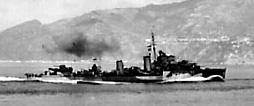 |
|
H62
Faulknor
|
The
Flotilla leader scrapped at Millford Haven in April 1946.
|
H78
Fame |
Sold to the Dominican in 1948 and renamed "General Issimo". |
 |
 |
 |
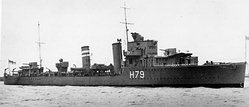 |
|
H76
Fearless |
Fatally damaged by Italian aircraft, scuttled by "Forester" Mediterranean 23.7.41. |
H79
Firedrake |
Torpedoed and sunk by U211 in the Atlantic 17.12.42 |
 |
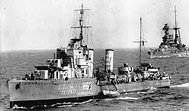 |
 |
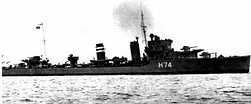 |
|
H68
Foresight |
Torpedoed by Italian aircraft sunk Mediterranean 12.8.42 |
H74
Forester |
Sold for scrap Rosyth June 1947 |
 |
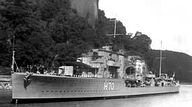 |
 |
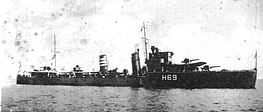 |
|
H70
Fortune |
Transferred to the Canadian Navy renamed "Saskatchewan" 1943 sold 1948 |
H69
Foxhound |
Transferred to the Canadian Navy renamed "Qu'Appelle" 1944 sold 1948 |
 |
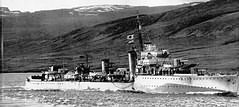 |
|
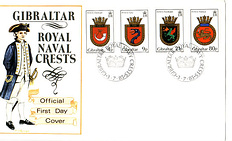 |
|
H76
Fury |
Fatally damaged by a mine off Normandy CTL; scrapped September 1944. |
HMS
Firedrake Stamp from Gibraltar |
An interesting find by Matt Liberty one of our members, is this set of first day issue stamps issued in Gibraltar in 1985 with the Firedrake's badge third from the left. |
|
Many
thanks to Mike Waugh for donating
the Ships Badges to this article you can see more if you visit
Ships Badges.
|
|
|
|
|
The
two very different sides
of HMS Firedrake |
|
| When
the Firedrake was painted in camouflage colours in 1941, she was
painted in two different stiles. These photos show the two very
different sides of HMS Firedrake. The photo right: was taken when the Firedrake was in dry dock at Gibraltar, and clearly shows that the pattern on the port-side is different to that of the starboard-side. The photo below and left: was taken by Telegraphist Maurice Stevenson onboard the Faulknor, the eighth Destroyer Flotilla leader, in very rough seas in the Mediterranean in 1941, This photo shows how different the design was on the port-side to that on the starboard-side. The photo below and right: was taken in the Mediterranean by some one on the battleship Nelson, it is of Firedrake's starboard-side as she returns to Gibraltar after being damaged by the Italian 500kilo bomb, when on "Operation Substance" in July 1941. This again shows how different the design was on the starboard-side to that of the port-side |
 |
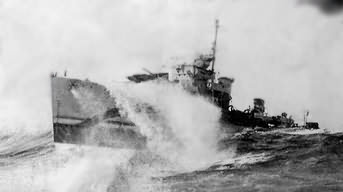 |
 |
 |
 |
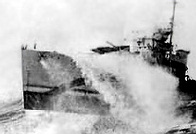 |
|
Starboard-side
|
Bow
|
Port-side
|
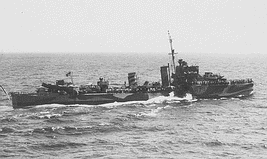 |
This group of four pictures from
left to right: Are the Firedrake with a wake from the damage sustained
by the near miss in the Mediterranean in 1941, then another photo
of the Firedrake in Gibraltar before she was damaged.
|
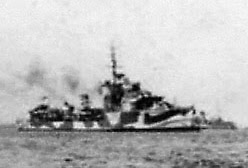 |
|
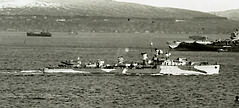 |
Second row: Two new photos of the Firedrake sometime after January 1942 in her new livery after the repairs had been carried out in America, the first one is of her entering the Clyde and the next one shows her in the Atlantic. |
 |
|
The HMS
Fame Mystery
|
|
| HMS
Fame was one of Firedrake’s sisters, one of the 8th destroyer flotilla,
she was at the sinking of U39 and at the second battle of Narvik.
On the 16th October 1940 the new battleship King George V, was nearing completion at Vickers Armstrong’s yard on the Tyne. Such a valuable but raw unit needed a powerful escort of cruisers and destroyers to take her up the coast to Scapa Flow. Six destroyers Fame, Ashanti, Maori, Sikh, Electra and Brilliant were ordered to carry out a high speed run through the Channel leading to the Tyne. These ships should thus produce enough magnetic and acoustic disturbance to simulate a battle ship’s passage and so detonate any mines of that nature in the channel. Their own speed should carry the destroyers safely away from the explosion. |
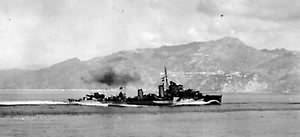 |
(
The scientific sweeping of ground mines was still in its early stages.)
It was vital that the Germans should not learn of the battleship’s
move and security was so tight that the destroyers had not been
told the purpose of their sweep, nor the ship they were supposed
to escort. Worse still, a navigational buoy had been moved and the
requisite chart corrections were lacking. Photo Left: HMS Fame at the second battle of Narvik. |
| At 0400, at almost full speed in murky drizzle, Fame ran straight onto the beach at Whitburn Rifle Range. Ashanti was right astern, going full speed astern and hard a port. For a moment a rumble through the ships hull sounded like depth-charges being dropped astern, then Ashanti still doing 7 knots struck the Fame a glancing blow on her port quarter and ended up alongside. The shock shattered oil fuel pipes in both ships boiler rooms, the Fame caught fire. Maori, next astern could not stop before touching the bottom but just managed to get off with the loss of her Asdic dome. The others stopped in time, but they still had no idea why they were there. Hearing all the commotion the defense post ashore thought the invasion had started and raised the alarm, but daylight showed the destroyers so high and dry they could be walked round at low tide. Sunderland Fire Brigade manhandled their pumps and equipment over the rocks to put Fame’s fire out. While her crew emptied her magazines. |
| Rising
tides found them still held fast by the bows. The swell lifted and swung their free sterns, dropping them on to the rocks and crumpling the bottom plating. In spite of collision mats and rubbers, Ashanti’s bow twisted and chafed through Fame’s side. One by one aerials and mast stays snapped. Damage control training in Ashanti included being sent down into the boiler rooms in breathing mask with the eyepieces blacked out, to shut down the boilers. |
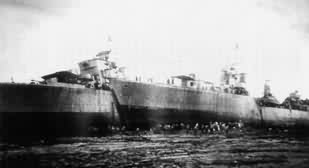 |
| Now was the time that such exercises paid off, as store rooms were emptied and equipment jettisoned. Oil fuel was everywhere. Some people were so immersed in it that for the rest of their service days they seamed to exude fuel oil whenever they perspired. |
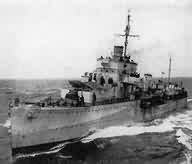 |
Vickers Armstrong sent their gangs with sheer legs and tackle to strip and lift out all armament, while the destroyer crews were accommodated in the rifle range huts ashore. Greenwall & Co. patched and welded and sealed off what they could during the brief hours of low tide and after a fortnight Ashanti (who had priority treatment) was re-floated and taken to Sunderland. Greenwalls made her more seaworthy for the longer tow to Swan Hunter & Wigham Richardson at Wallsend on the Tyne for complete rebuilding. Fame also lived to run again, but the affair was a closely kept secret. King George V, meanwhile slipped up the coast virtually unescorted. |
| Fame was out of service for two years re-entering service in 1942. She then sank U353 while in escort group B6 escorting convoy SC 104. On the 17.2.43 she sank U201. And D-day joined support group 14 for anti-u-boat patrols in the English Channel and Bay of Biscay. On the 18.4.44 with others of S.G.14 she sank U-boat U767 in the Channel. She then served in A/S training Flotilla post war until sold to the Dominica in 1948 and renamed General Issimo. |
|
Other
Pages Below
|
